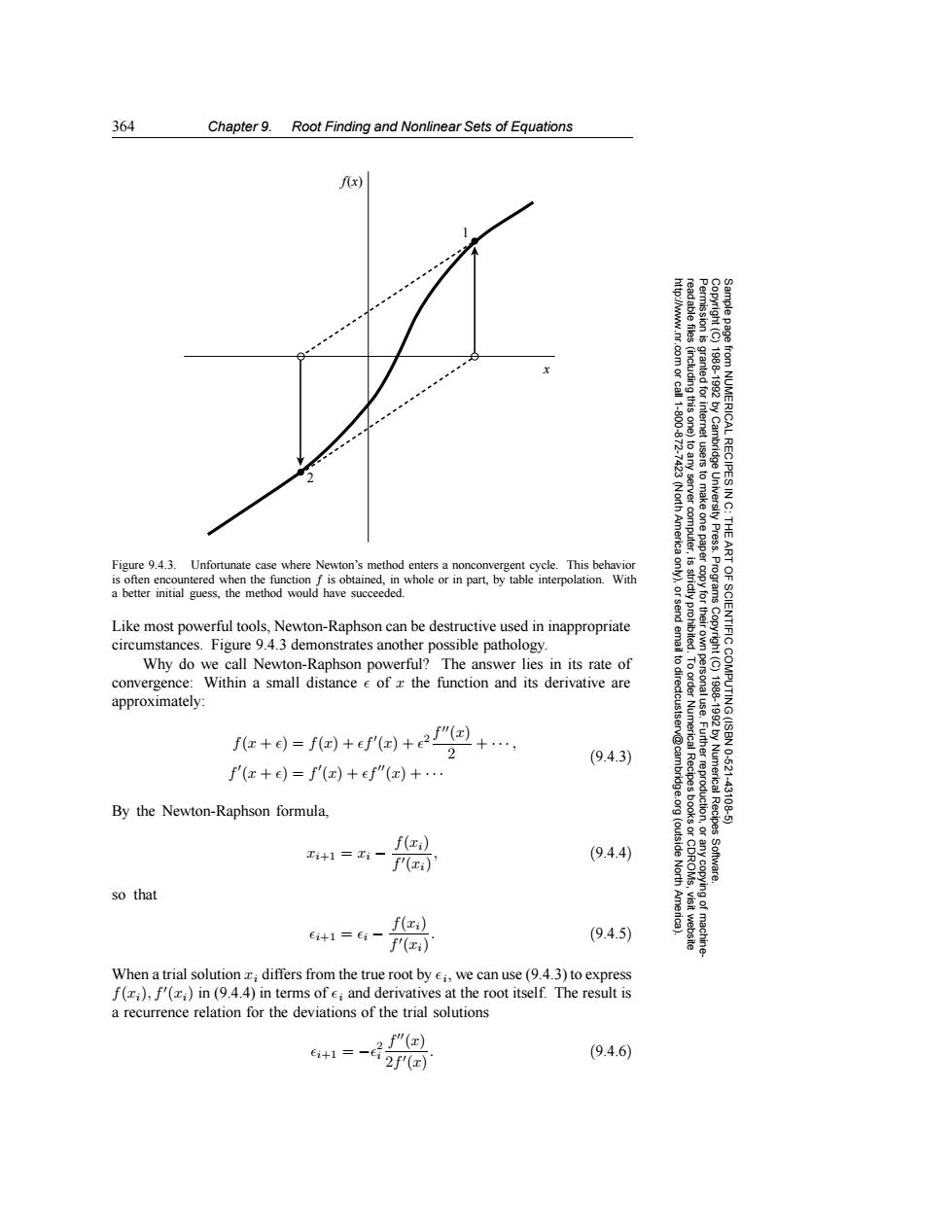正在加载图片...

364 Chapter 9. Root Finding and Nonlinear Sets of Equations f(x) http://www.nr.com or call 1-800-872- Permission is read able files (including this one) granted for from NUMERICAL RECIPES IN C: 19881992 by Cambridge to any server computer, -7423 (North America tusers to make one paper e University Press. THE Figure 9.4.3.Unfortunate case where Newton's method enters a nonconvergent cycle.This behavior ART is often encountered when the function f is obtained,in whole or in part,by table interpolation.With 是 a better initial guess,the method would have succeeded. ictly proh Programs Like most powerful tools,Newton-Raphson can be destructive used in inappropriate circumstances.Figure 9.4.3 demonstrates another possible pathology. Why do we call Newton-Raphson powerful?The answer lies in its rate of to dir convergence:Within a small distance e of z the function and its derivative are approximately: 1881892 OF SCIENTIFIC COMPUTING(ISBN f+)=fa)+efa)+e2f"四 十· 2 (9.4.3) f'(x+e)=f(x)+ef"(x)+… Numerical Recipes 10-521 43108 By the Newton-Raphson formula. f(xi) (outside i+1=i一 f'(xi) (9.4.4) North Software. so that f(xi) Ei+1=Ei- visit website f'(x) (9.4.5) machine When a trial solution x;differs from the true root by ei,we can use(9.4.3)to express f(),f'()in (9.4.4)in terms of e;and derivatives at the root itself.The result is a recurrence relation for the deviations of the trial solutions 2f"(x) 6+1=-6f2f(m (9.4.6)364 Chapter 9. Root Finding and Nonlinear Sets of Equations Permission is granted for internet users to make one paper copy for their own personal use. Further reproduction, or any copyin Copyright (C) 1988-1992 by Cambridge University Press. Programs Copyright (C) 1988-1992 by Numerical Recipes Software. Sample page from NUMERICAL RECIPES IN C: THE ART OF SCIENTIFIC COMPUTING (ISBN 0-521-43108-5) g of machinereadable files (including this one) to any server computer, is strictly prohibited. To order Numerical Recipes books or CDROMs, visit website http://www.nr.com or call 1-800-872-7423 (North America only), or send email to directcustserv@cambridge.org (outside North America). x f(x) 2 1 Figure 9.4.3. Unfortunate case where Newton’s method enters a nonconvergent cycle. This behavior is often encountered when the function f is obtained, in whole or in part, by table interpolation. With a better initial guess, the method would have succeeded. Like most powerful tools, Newton-Raphson can be destructive used in inappropriate circumstances. Figure 9.4.3 demonstrates another possible pathology. Why do we call Newton-Raphson powerful? The answer lies in its rate of convergence: Within a small distance of x the function and its derivative are approximately: f(x + ) = f(x) + f (x) + 2 f(x) 2 + ··· , f (x + ) = f (x) + f(x) + ··· (9.4.3) By the Newton-Raphson formula, xi+1 = xi − f(xi) f (xi) , (9.4.4) so that i+1 = i − f(xi) f (xi) . (9.4.5) When a trial solution xi differs from the true root by i, we can use (9.4.3) to express f(xi), f (xi) in (9.4.4) in terms of i and derivatives at the root itself. The result is a recurrence relation for the deviations of the trial solutions i+1 = −2 i f(x) 2f (x) . (9.4.6)